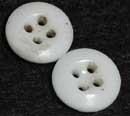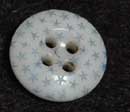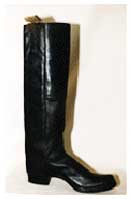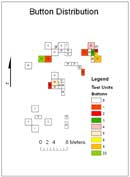Buttons
Introduction
Buttons are one of the few items of material culture that many if not most people have in common. Buttons are part of everyday life and people use them without giving a second thought. Buttons are small, precariously attached to and positioned on clothing, and are often lost. Rarely are buttons found when they are lost; more likely the loss is not noticed until a time when it is impossible to find the button. Thus, buttons are commonly recovered from archaeological sites such as Beaver Crossing. An interesting thing about buttons is that each has its own story. Button types range from those that are home-made out of bone or shell to those that are intricately designed, metal buttons carrying rank or affiliation.
Prosser Buttons
At the Beaver Crossing site, Prosser buttons were the most common kind of button recovered. These buttons are made of fine clay containing finely ground quartz or other ceramic wasters. A little moisture, milk, or water could be added to improve plasticity. The clay is pressed into cast-iron molds and fired at high temperatures. The combination of high pressure and high temperatures creates a hard button.
Prosser buttons date after 1840 and there are several types. Calico Prosser buttons were produced in the United States after 1848 (Barber 1909:444). It is possible that calico buttons were still being produced until 1910. Piecrust Prosser buttons are thought to date from 1840–1880. Four-hole, smooth beveled rim, or dish type Prosser buttons account for 98 percent of all the buttons in the archaeological record. At Beaver Crossing, these plain white Prosser buttons which are ceramic account for 50 percent of the buttons excavated (Figure 7.1).
The most common types of Prosser buttons are four-hole dish type, pantywaist, and piecrust (Sprauge 2002). Figure 7.2 shows four-hole dish type Prosser buttons. Of these three button types, all but the pantywaist (Figure 7.3) were found at Beaver Crossing. A central group of units including test units 18, 30, 31, 33, 34, 36, 38, and 39 (to be referred to as the central units) held four plain, four-hole, dish type Prosser buttons.
The buttons recovered from the site were of various diameters. Fifteen buttons were between 10 and 12 mm in diameter and one had a diameter of 8 mm. The group of test units in the northeast corner of the site held seven buttons between 10 and 12 mm in diameter and one at 8 mm in diameter. Two matching, green, four-hole buttons, found in test unit 37, had a radius of 11 mm. A 10 mm in diameter button with a raised edge was found in the same unit, but one level deeper. The metric system was used to measure the diameter of the buttons found in this study; however, during the time of the buttons manufacture, the "line" was the unit of measurement. For example, one line equals 1/40 in. or .025 in. Sears, Roebuck & Co. (1897) has a scale that can be used for some rough estimations of button size. These buttons were between 10 and 11 mm which equates to between 16 and 18 lines (Israel 1968).
One button that needed its own category is a small three-hole Prosser button found deep in test unit 12. This type of button was most likely used on infant or doll clothing (Sprauge 2002). In the northeastern units, five of the 13 buttons were not the plain white Prosser buttons. At a site where this plain button was common, it is unusual to see so many stylized buttons close together. The central units contained only one decorated button out of the five recorded. This button was a four-hole, dish type calico (Figure 7.4). The design was blue stars on a white button. This design appears more intricate than the green spots which occur on another calico button. This green and white calico was found in the unit directly north of the two green four-hole buttons mentioned earlier. In total, there were twenty-eight Prosser buttons found at this site.
Natural Material Buttons
Six bone buttons were found at the site; test unit 12 contained five of them. These were all four-hole dish type buttons. They were cut out of a pattern bone. Four of them are broken and were found deeper than the single whole button, which was found in level 3. The other two natural material buttons were made of shell. A 10 mm black shell button was found in unit 12. This button has no holes in center. There are concentric rings that move towards a slightly raised center. This button possibly served as a cuff link inset. The northeastern set of units held one 10 mm two-hole shell button (Figure 7.5). This button is relatively narrow. It appears too delicate to actually hold clothing in place, and too plain to serve as a decorative touch. Most likely, its function was to hold something closed.
Metal Buttons
Metal buttons were abundant at this site. There were 21 metal buttons of various types, including three military buttons. Each of the military buttons was found in a different test unit; however, each was located along the same plane of the site grid's Y-axis (Figure 7.11). All three buttons were found in test units with a border on 5087 N. The loss of buttons along one plane could be due to repeated marches over the same trail.
Test unit 12 contained a brass button with a representation of an eagle with its wings spread. Over the eagle is a shield with a recessed R (Figure 7.6). This button can be dated between 1846 and 1861. The back mark reads "Corvallis & Co Extra," dating the button to around 1850 (Trice 2003).
The next military button found was a 20 mm three-piece button, found in test unit 37. It shows a symmetrical spread eagle holding a lined shield (Figure 7.7). This button can be dated in two ways. Using Wycoff's (1984) analysis of military buttons, it is identified as an enlisted man's button from between 1847 and 1880. The back mark reads "Scovill M F G Co Waterbury" (Figure 7.8). This mark narrows the date of manufacture to between 1850 and 1860 (Trice 2003).
The third military button was an unexpected find for an archaeological site in Nebraska. This Naval button was found in test unit 40, next to the enlisted man's button. This 13 mm button depicts a left-facing eagle sitting atop an anchor surrounded by stars. The rim of the button has a border of rope. This design matches the design of a Naval button from the 1830s, but it is too small to be the same (Trice 1997). Perhaps this was a gaiter or cuff button instead of a coat button. This would help to explain why it matched the style of buttons, but not the correct size.
Shoe Buttons
A type of button that is somewhat strange and not found in greater numbers is a shoe button; only a single bullet button recovered from the site could belong to a shoe. During this time period, shoes with buttons were the fanciest of shoes. There were some styles of ladies' shoes offered in both button up and lace up styles, though it is unlikely that many women opted for the button up style. Button shoes were often impractical and required a tool to fasten. Walking was the most common form of travel on the trail which made such shoes impractical. In her journal, Mary Ellen Murdock Compton, who was on the Oregon Trail in 1853, said she brought ten pairs of shoes on the trail. She wore out nine pairs, and walked the last miles barefoot so she would have a nice pair to wear into Oregon County (Rusler 2004). There were several types of shoes that would have been present on the trail. Cowboy boots diverged from other shoes in the 1880s (Figure 7.9) so by the 1860s when Beaver Crossing was occupied; they may have been present in an early form (Frommer 2005). These boots came in both pull-on and lace up styles, but the pull-on style appears to be most popular, based on historical photographs.
As the site contained three military buttons, it can be assumed that military boots were also present. Military boots differ from cowboy boots in construction. Cowboy boots are made of four pieces and they have seams up the sides. Military boots have a single seam up the back (Frommer 2005).
Other shoes are likely lace up; metal eyelets were not patented until the 1890s (Wardrobe Clothing and Uniforms 2005). It seems unlikely that people would buy the highest style shoes for their trip on the trail. This explains why parts of shoes were found, though no metal eyelets were recovered from the site. Embellishments like eyelets were unnecessary; the sole of the shoe was likely to wear out before the shoelace holes tore. The next style of shoes that may have passed through this site was the pull-on with elastic. Elastic was patented in 1837 (Wardrobe Clothing and Uniforms 2005). Some immigrants may have also purchased moccasins from Native Americans. This lack of shoe buttons is not surprising given the rigors of trail life. The fact that there were no metal eyelets and only one possible shoe button suggests that even though this was a way station it was not likely a site where one dressed for the occasion. Mary Ellen Murdock Compton saved one pair of shoes for Oregon County (Rusler 2004); this shows that people would break out their nice items when they were going into towns. If there were fancy occasions, there would have been more evidence of formal attire; the embellished buttons recovered also represent this trend. Prosser buttons and metal buttons both come in much fancier forms than those found at Beaver Creek. The fanciest Prosser buttons found at the site were a dish type calico. There are many other button types that should have been present if the high fashion clothes were worn with any frequency. The metal buttons were also plain. Even the most embellished, the "X design" and the "Shamrock," (Figure 7.10) were relatively small. It appears this was a site to camp and clean, but not to break out the formal attire.
Discussion and Conclusion
Camping at this site could account for some of the loss of buttons away from the feature interpreted as a fire pit. In Nebraska, even summer nights can get cool. If people are trying to finish their tasks, they are likely to be rushing around and may catch their clothes and lose buttons. Even if the loss is noticed, it is unlikely that anyone would take the time to find a button in the dark.
The buttons are all small; the average size of buttons on this site is 12.5 mm. The buttons 14 mm or larger were all made of metal. This suggests that most of the activities in the northern region of the site took place in the summer. If the occupants were active in the winter there should be a higher portion of large diameter buttons as the small buttons would have been used for shirts or women's dresses, but they were not large enough to be overcoat buttons.
The distribution of the buttons is shown in Figure 7.11. Test unit 12 was where 19 of the 54 buttons were found. This unit accounts for 35 percent of the buttons at the site. The next highest density unit is 37, which held nine buttons or a mere 16 percent. Only one test unit, 41, held more than four buttons.
Test unit 12 contained a large burned feature. Many of the artifacts found in this unit were heat altered; however, none of the buttons appeared to have any signs of heat alteration. On the trail, a fire would have served many significant purposes. It would have been a place to cook food, heat wash water, and socialize. This feature would have been a center of activity, and the care of personal clothing items took place here. There was no "delicate cycle" when it came time to wash clothes on the trail. Many fabrics worn were materials that now are dry-cleaned. Wool is a clear example. Clothes shrank unevenly, and dyes often ran. Certain steps were taken to make washing easier. The gathers in clothing were not permanently stitched like modern day skirts. Instead, clothes were pleated with a drawstring. This made them easier to iron and dry. Less laundry was produced in the nineteenth century, as people were likely to change their shirts and undergarments only once a week (DeMarce 2002).
Doing laundry was a multi-step process; water had to be carried from the creek or well to the fire. Wool items were washed separately in cold water, but the rest of the clothes were soaked in warm soap water. After they soaked, a washboard was used to loosen the dirt. The first zinc washboards were introduced in 1848; before this time rocks, wooden stompers, or lots of handwork was needed to do laundry (Timeline 2003). The next step was to put the clothes into boiling water and stir them with a large heavy stick. Finally, the clothes were rinsed and hung to dry. In the summer, drying clothes was easy, but when it was cold, it could take days or weeks to get clothes to dry. If the clothes needed to be ironed, an iron was heated in the embers of the fire. Ironing was done as rarely as possible. Irons often became too hot, and the clothes were easily scorched. There was also a risk of ashes staining the freshly washed clothes. This meant the item would need to be washed again, which was rather tedious (Keller and Naedau 1998).
The scrubbing of clothes was a rough process, so it is likely that many buttons were ripped off of clothing in the washing process. It is easy to miss the loss of a button when the clothes are in a big wet pile. Perhaps this is the reason that so many buttons were not salvaged. People may not have noticed the loss of a button until the next time the clothing was worn. Many of the buttons found were plain Prosser buttons. These would have been relatively cheap to replace. The process used to manufacture these buttons made it cheaper to make a button than the effort involved in looking for a lost button or saving extra buttons (Sprauge 2003). Buttons were easy to store and display, so they were easy to buy and replace. The sewing needle found in unit 12 suggests that this was a site for many different activities. Perhaps this was a place for women to gather socially while doing their many tasks around the fire.
While this feature was burned, none of the buttons showed any evidence of heat alteration. There are two possible explanations for this finding. First, most of the buttons could have fallen off of the clothing when it was being scrubbed on the washboard. These buttons would have ended up at the bottom of the washbasin. When the washing was finished the fire had to be put out and the wash water may have served as a fire extinguisher. This water would have put out the fire before it had a chance to burn the buttons. Second, when the dirt was kicked into the fire to put it out, buttons that had fallen to the ground ended up in the fire.
Beaver Crossing was clearly a center of activity. When people reached the way station, they had a chance to complete tasks that had been neglected along the way. One of these tasks was laundry. At first it may seem curious that a group of people so determined to salvage everything they could from this site would leave so many reusable buttons just lying on the ground. Once this site is examined closer it becomes clear that most of the buttons are in one area; this area is near the burned feature. The travelers did not lose buttons and just let them lay; chances are they lost buttons because they did not care to find them. They were doing many activities around the camp, and could not waste valuable time looking for a cheap and replaceable resource such as a button.
Figures

Figure 7.3. Sample of pantywaist buttons. These belong to a private collection and were not found at the Beaver Crossing Site.

Figure 7.5. Shell, 10 mm, two-hole hand-drilled disc button. The holes in this button are too small to be a pantywaist button.

Figure 7.6. Brass, symmetrical Spread Eagle button, "R" recessed on the shield mounted rifle man. "Scovills &Co. Extra" back mark (Wyckoff 1884:62) c. 1846–1861.

Figure 7.7. Brass, 20 mm (Wycoff 1984:88), symmetrical Spread Eagle, lined shield, three piece, 1847–1880, back "Scovill M F G Co Waterbury," (Trice 2003) "1850–1860" button.

Figure 7.10. Brass South type 7, 12mm, no eye, shamrock button (Finnians), eighteenth-nineteenth century.
References
about.com
1904 Whitcomb's Flexsole Shoes Advertisement. Ladies Home Journal about.com.
Electronic document, http://antiques.about.com. Path:library, accessed December 10, 2005.
Barber, Edwine Atlee
1909 The Pottery and Porcelain of the United States. G.P. Putman's
Sons, New York.
DeMarce, Virginia
2002 Reflections on Early Modern Laundry. Online posting, http://homepage.mac.com/msb/163x/faqs/laundry.html, accessed December 10, 2005.
Frommer, D. W.
A History of the Western Boot. WorldShoeNet Worldwide Info
Center. Shoeinfonet. Electronic document, http://www.shoeinfonet.com, path: About Shoes: Shoe History: History of the Western Boot, accessed December 9, 2005.
Keller, Robin L., and Michael Naedau
1998 Visual Dictionary: A Day in the Life of a Pre-Industrial Woman. Edited by David Lux, Bryant College. Electronic document, http://web.bryant.edu/~ehu/h364proj/fall_98/keller/index.htm, accessed December 10, 2005.
Israel, Fred L.
1968 1897 Sears and Roebuck Catalogue. Chelsea House Publisher, Philadelphia.
National Park Service
2004 Pioneer Tidbits: Interesting facts about Pioneers and Their Way of Life.
Whitman Mission NHS-History and Culture, Electronic document, http://www.nps.gov/whmi, accessed December 6, 2005.
Second Wisconsin Volunteer Infantry Association Inc.
2003 Timeline: A Brief History of Fashion and Equipment, Second Wisconsin
Volunteer Infantry Association Inc., Electronic document, http://secondwi.com/index.htm, accessed February 10, 2006.
South, Stanley
1964 "Analysis of the Buttons From Brunswick Town and Fort Fisher." The Florida Anthropologist 17(2):113–133.
Sprague, Roderic
2002 "China or Prosser Button Identification and Dating." Historical Archaeology 36 (2):111–127.
TIAS
1999 Button Dictionary. Button Bytes Light. TIAS.
Electronic document, http://tias.com/articles/buttons, path: dictionary, accessed November 10, 2005.
Trice, Warren K.
1997 Uniform Buttons of the United States. Thomas Publications, Gettysburg.
2003 Dating Buttons: A Chronology of Button Types, Makers, Retailers, and Their Backmarks. First Printing, Essex Junction, Vermont.
USHist.com
Wardrobe Clothing & Uniforms: Victorian; Civil War, Indian War, Old West, and
Span-Am War. Electronic document, http://ushist.com/wardrobe.htm, accessed December 10, 2005.
Wycoff, Martin A.
1984 United States Military Buttons of the Land Services, 1787–1902. McLean County Historical Society, Bloomington, Illinois.







